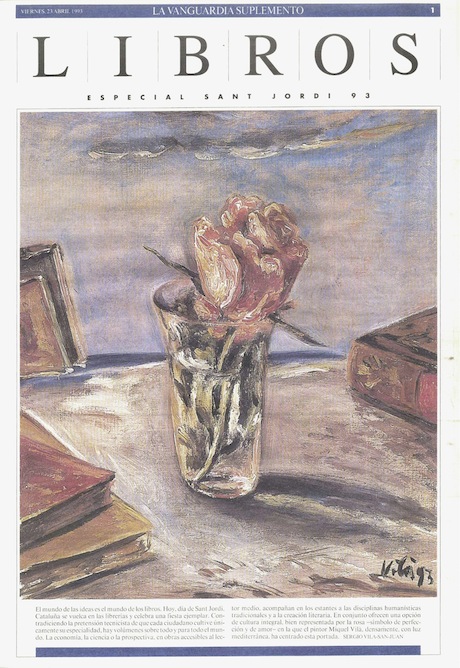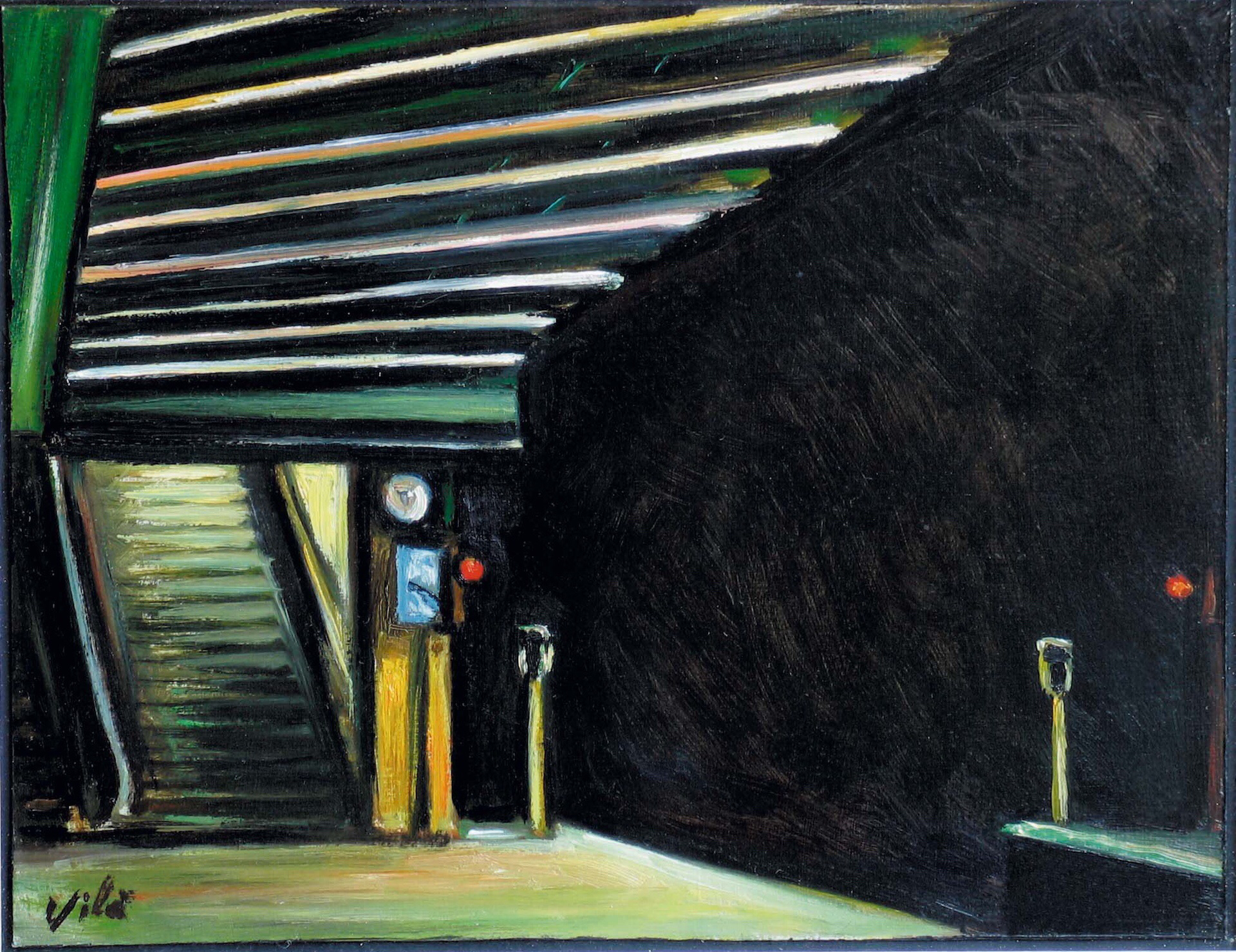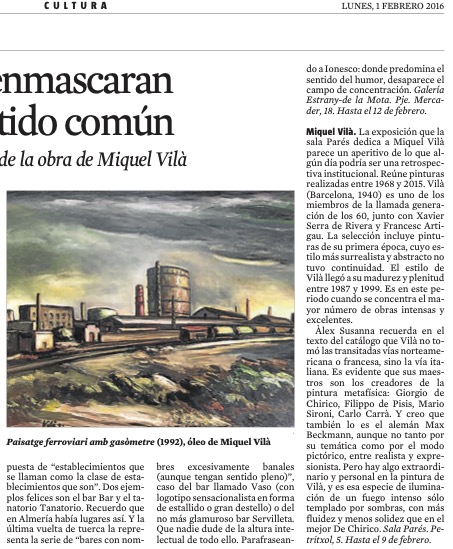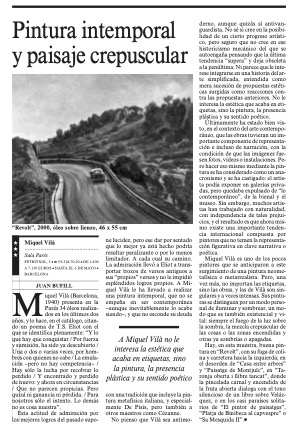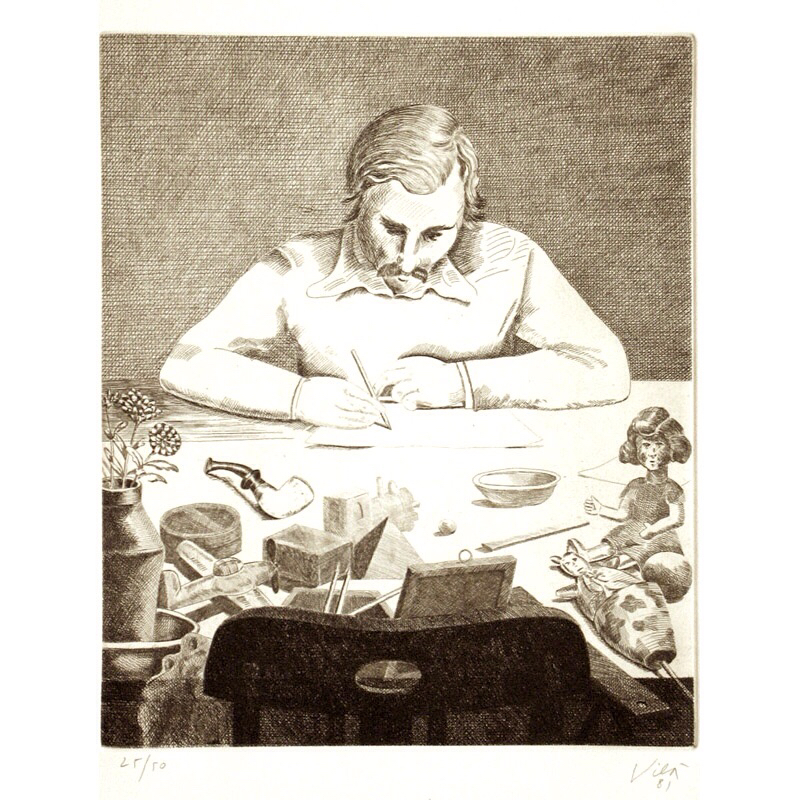Alex Susanna
Miquel Vila or the subversion of the real
On the occasion of its seventy-fifth anniversary, Sala Pares hosts a large retrospective exhibition by Miquel Vila, one of the most unique Catalan artists of the last forty years. But what do we mean by singular? Someone endowed with a strong personality, someone who at all times has fostered optimal growth of his work, and someone endowed with great faith in his craft. Personality, growth, faith. But perhaps above all Miquel Vila has been someone able to create his own imaginary, therefoe we are already talking about talent.
Holding an incorruptible and persevering talent, as shown by the exhibition we present, which summarizes a trajectory of almost half a century: from some of those first works -between surreal and indebted to pop art- which he exhibited in 1968 at the Ianua (Barcelona) or Pecanins (Mexico) galleries, or in 1969 at L'Agrifoglio (Milan) and The Mande Kerns Center (Eugene, Oregon), to paintings painted in recent years at his study in Barcelona or Menorca, in which his work seems to have reached an extreme degree of condensation. Minimal still lives, landscapes without anecdote: pure plastic.
It is therefore an exhibition that both the artist and Sala Pares -his gallery since 1990- owed us, so that the first thing we must do is to celebrate it properly. It is not yet the great retrospective that Miquel Vila deserves, but perhaps it is the preamble. And, at any rate, the choice of these sixty works becomes not only a real compendium of motifs and genres but as an excellent gateway to their world. If you wish, it is an infrequent exhibition format — like the equivalent of a poetic anthology — but very useful and suggestive for bringing the work of our modern classics closer to new generations and giving others the opportunity to take an express trip throughout his career.
The work of Miquel Vila is, in appearance, the one from an outsider, from someone who seems to have moved along the gutters of the main currents of art of our time. But if you look closely, it's not even close to what it seems: if there is a cultured painter, traveled and read, that’s him. A painter, moreover, endowed with a high degree of self-awareness. The grace of it all is that this has made him extremely independent: as is often the case in these cases, he has chosen his predecessors - the affinities that for some reason are called elective - and has never stopped talking to them. Instead of the much more crowded French or American routes, he has preferred to travel mainly through Italy and is therefore with some of the leading painters of the twentieth century who, since the mid-seventies, he has talked to more , when his work finds its own tone : Carrà, Sironi or De Pisis, to name just a few. However, they are not the only ones.
Therefore, contrary to what it may look like, we must not see Vila's work as the more or less melancholy expression of a soliloquy but quite the opposite. Earlier we mentioned some Italian painters but now it's time to add his own peers: Josep Vives Campomar, Xavier Serra de Rivera and Francesc Artigau are perhaps those with whom he has sustained a more fertile relationship. And, as a matter of fact, this has produced many joint exhibitions. All of them are part of the so-called generation of the 60s, one (by the way) of the most invisible at our public museums.
Be that as it may, you recognize his paintings -almost always- immediately: there is usually a "Vila’s atmosphere", as Francesc Fontbona said in the prologue to our artist's Reasoned Catalog (2004), which emerges in every piece of work and ends to set up a world on his own. A world made of both external and internal references: apparently we find the same motifs or pre-texts, but more than their visible and recognizable materiality what it matters to us is the point of view from which they are observed, or rather presented.
A perspective that is always very subjective and fruitful, often disturbing and all: the physicality of its landscapes -industrial or natural- usually crystallizes in a world of a certain unreality, in the same way as the objects that inhabit its still lives are almost always - out of place - but that's why they create completely unexpected magnetic fields. The subversion of the real, here is the motto that implicitly presides over much of his work.
Now, where does this light comes from that someone did not hesitate to relate to that of Nonell? A dramatic light, autumn evening. An inner light, unctuous, oily, that seems to drip through the skin of objects, or of the landscapes themselves. A fluorescent, end-of-cycle light. That underlines, sotto voce, the loneliness of things and the distance from the landscapes around us, both the industrial ones -already gone- and the natural ones, to which it has more and more appeal. A light that is probably the greatest conquest of the artist and at the same time a sign of his unequivocal loneliness. And, as Jordi Gabarró said, "Miquel Vila perfectly symbolizes this struggle of today's great painters against the death of Painting".
Alex SUSANNA
Miquel Vila or the subversion of the real
On the occasion of its seventy-fifth anniversary, Sala Pares hosts a large retrospective exhibition by Miquel Vila, one of the most unique Catalan artists of the last forty years. But what do we mean by singular? Someone endowed with a strong personality, someone who at all times has fostered optimal growth of his work, and someone endowed with great faith in his craft. Personality, growth, faith. But perhaps above all Miquel Vila has been someone able to create his own imaginary, therefoe we are already talking about talent.
Holding an incorruptible and persevering talent, as shown by the exhibition we present, which summarizes a trajectory of almost half a century: from some of those first works -between surreal and indebted to pop art- which he exhibited in 1968 at the Ianua (Barcelona) or Pecanins (Mexico) galleries, or in 1969 at L'Agrifoglio (Milan) and The Mande Kerns Center (Eugene, Oregon), to paintings painted in recent years at his study in Barcelona or Menorca, in which his work seems to have reached an extreme degree of condensation. Minimal still lives, landscapes without anecdote: pure plastic.
It is therefore an exhibition that both the artist and Sala Pares -his gallery since 1990- owed us, so that the first thing we must do is to celebrate it properly. It is not yet the great retrospective that Miquel Vila deserves, but perhaps it is the preamble. And, at any rate, the choice of these sixty works becomes not only a real compendium of motifs and genres but as an excellent gateway to their world. If you wish, it is an infrequent exhibition format — like the equivalent of a poetic anthology — but very useful and suggestive for bringing the work of our modern classics closer to new generations and giving others the opportunity to take an express trip throughout his career.
The work of Miquel Vila is, in appearance, the one from an outsider, from someone who seems to have moved along the gutters of the main currents of art of our time. But if you look closely, it's not even close to what it seems: if there is a cultured painter, traveled and read, that’s him. A painter, moreover, endowed with a high degree of self-awareness. The grace of it all is that this has made him extremely independent: as is often the case in these cases, he has chosen his predecessors - the affinities that for some reason are called elective - and has never stopped talking to them. Instead of the much more crowded French or American routes, he has preferred to travel mainly through Italy and is therefore with some of the leading painters of the twentieth century who, since the mid-seventies, he has talked to more , when his work finds its own tone : Carrà, Sironi or De Pisis, to name just a few. However, they are not the only ones.
Therefore, contrary to what it may look like, we must not see Vila's work as the more or less melancholy expression of a soliloquy but quite the opposite. Earlier we mentioned some Italian painters but now it's time to add his own peers: Josep Vives Campomar, Xavier Serra de Rivera and Francesc Artigau are perhaps those with whom he has sustained a more fertile relationship. And, as a matter of fact, this has produced many joint exhibitions. All of them are part of the so-called generation of the 60s, one (by the way) of the most invisible at our public museums.
Be that as it may, you recognize his paintings -almost always- immediately: there is usually a "Vila’s atmosphere", as Francesc Fontbona said in the prologue to our artist's Reasoned Catalog (2004), which emerges in every piece of work and ends to set up a world on his own. A world made of both external and internal references: apparently we find the same motifs or pre-texts, but more than their visible and recognizable materiality what it matters to us is the point of view from which they are observed, or rather presented.
A perspective that is always very subjective and fruitful, often disturbing and all: the physicality of its landscapes -industrial or natural- usually crystallizes in a world of a certain unreality, in the same way as the objects that inhabit its still lives are almost always - out of place - but that's why they create completely unexpected magnetic fields. The subversion of the real, here is the motto that implicitly presides over much of his work.
Now, where does this light comes from that someone did not hesitate to relate to that of Nonell? A dramatic light, autumn evening. An inner light, unctuous, oily, that seems to drip through the skin of objects, or of the landscapes themselves. A fluorescent, end-of-cycle light. That underlines, sotto voce, the loneliness of things and the distance from the landscapes around us, both the industrial ones -already gone- and the natural ones, to which it has more and more appeal. A light that is probably the greatest conquest of the artist and at the same time a sign of his unequivocal loneliness. And, as Jordi Gabarró said, "Miquel Vila perfectly symbolizes this struggle of today's great painters against the death of Painting".
Alex SUSANNA
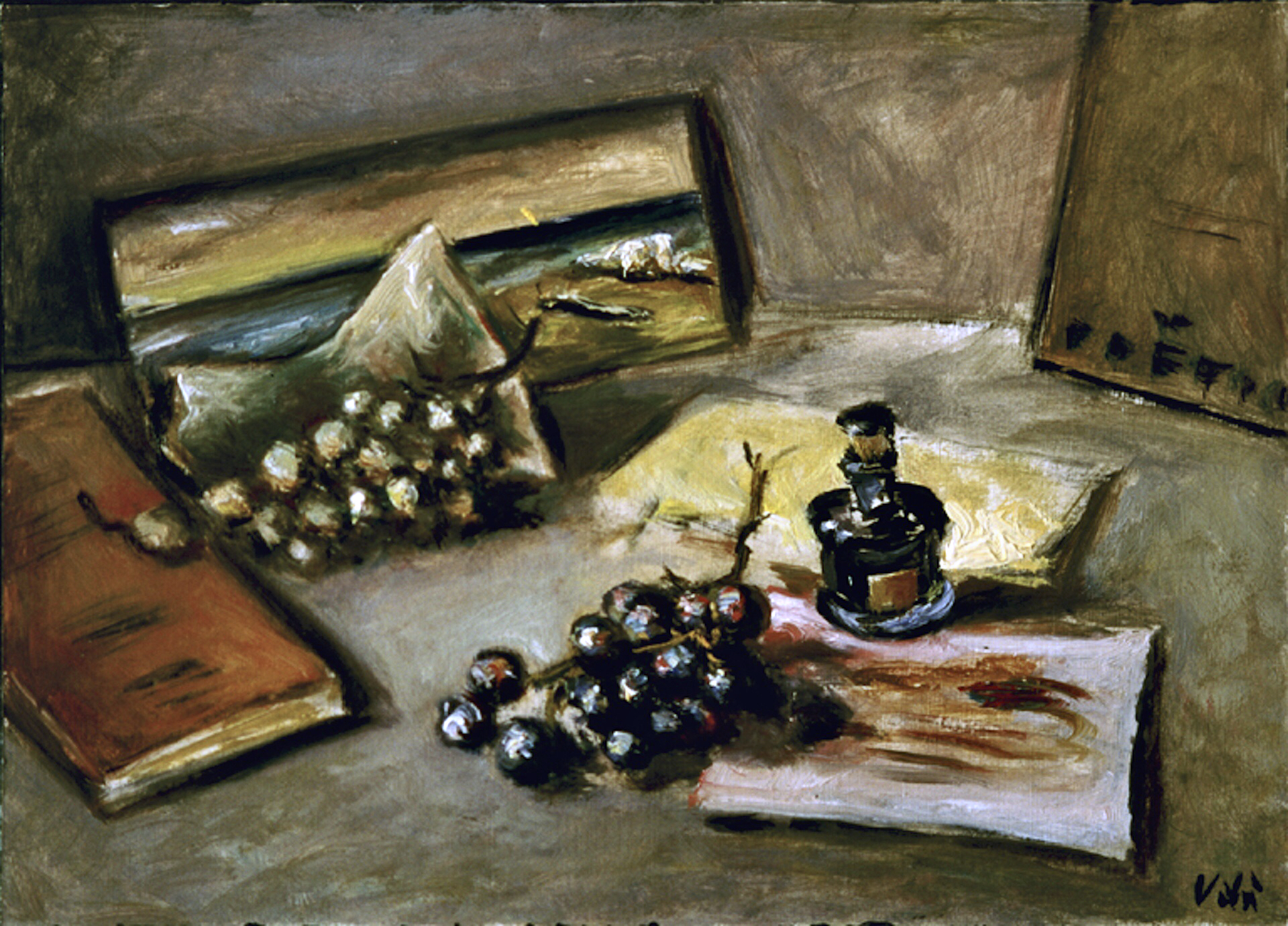
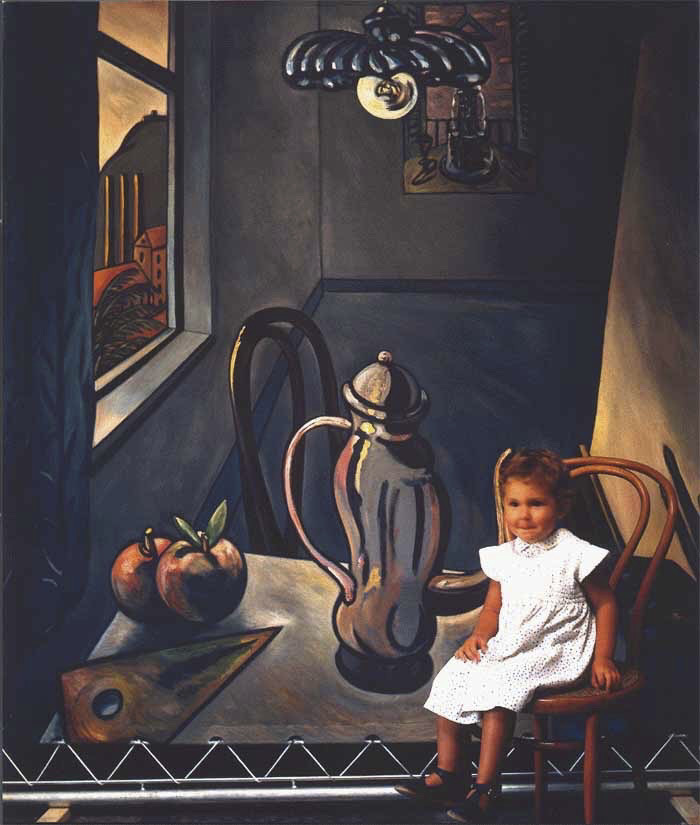
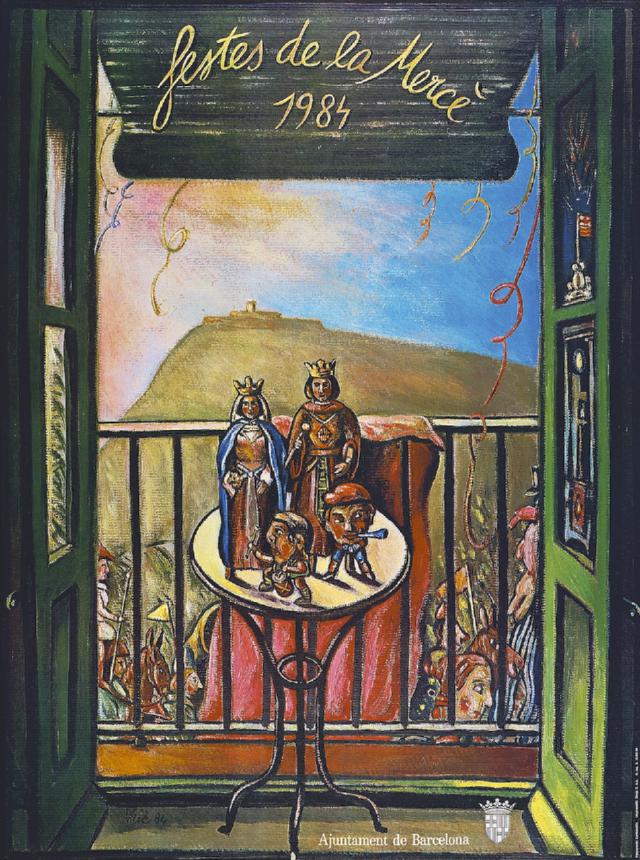
Rafael Santos Torroella
I watched closely the beginning of Vilà's career. At that time he was fully committed to what it seemed to be his true vocation: etching. At that time when he worked with Torralba, another well known etcher, I even helped in the creation of some of the magnificent books edited by them.
Later, with this sort of shy and silent attitude so common in him, he started to become known for what he was really after: to become a painter. By that time a whole generation from Barcelona, sometimes referred as the generation of the 60s, were hurrying up to get a prominent place: Artigau, Arranz Bravo, Bartolozzi, Llimós, Gerard Sala, Serra de Rivera, just to mention a few. With the latter, outstanding etcher as well, Vilà would share certain affinity to Magritte, a sort of detour which both made to get to what they probably felt it was their most desired aim: a realism with no constraints. A realism that would be true in his natural presence and, at the same time, it would be a recreation or an answer from Painting to Itself.
Afterwards, I saw him advancing lonely, slowly, and stubbornly. At times with some difficulties, but feeling more and more, from his obstinacy, justified by his determination to do it.
Every time I have revisited his work again, at times after long time gaps, I was surprised to find out in his paintings something new, new here meaning different, and I saw him closer to his final goal. Whatever this one would be, it was more a sort of presentiment rather than a clean sketch before his eyes.
However, several years ago, in the mid-eighties, I started to notice in his work, here and there, an unequivocal sudden shine that forced me to restate the same question once again: How does it come that Isidre Nonell, to me the most profound painter that Catalonia has had in modern days, remains with the shining trace of his footprints stopped in time as a glare in the shadows?
I hope that Vilà don't consider me to be impertinent or frivolous if I ask the above question with regard to his paintings. Surely enough, that should not distract him. Yet, I would be way off if I tried to assign to him any kind of mimetic style. Everybody chooses or meets his best friends. And I am pretty sure that among those who were named by Goethe as the 'selective affinities' Vilà would include Nonell and many others. For instance, I listened to him talking about Corot. This, in my opinion, is very consistent with his Nonell's affinities. Perhaps with the latter it is sort of personal and intimate, as it would be arising from his own personal environment.
When talking about Nonell it is absolutely mandatory to mention Francesc Pujols from whom we owe the most fresh and alive views about him. He claims that what Nonell did was to get straight to the essence of beauty, which in the irreplaceable thinker of 'The Tower of the Hours' was a synonymous of life in the fullness of its ripe: "getting rid of everything that makes what classicism is all about, in order to extract from the minimum amount of it, the maximum primordial amount from its substance. If that is feasible. In order that, eventually, the work of art becomes pure essence, as if we would squeezing beauty again and again to bleed it dry."
When looking at the last three Vila's Menorca campaigns, the names of Pujols and Nonell come to my mind again. I see in those exhibitions something described so graphically by the former and savored in such an intense way in the latter. I can see this either in the gravity and the absorbed withdrawal of his Gipsies, as I do in his still life works which are pure and medullary pictorial essence. In the sense that Pujols is using that expression. Thus, we quickly notice that something is going on with Vilà's colors. They are true colors, strong colors, but not only in the shade of their inks or pigments but also because of that value about which the philosopher from Martorell enjoys talking about. These are therefore, vital, substantive colors, that do exist by themselves, towards the inside rather than towards the outside. They don't remain merely on their surface, which is often the case with those painters usually labeled as 'colorist'. If anybody would be surprised by the color density of our painter, being him so much opposed to any superficial inconstancy, he could quote the old Rembrandt when he said to a certain customer who was raising objections of that sort to one of his latest works: "Sorry sir, I am a painter, not a dyer".
This is where the corporeality of things in Vilà's still life paintings comes from. Rather than coming from the shapes themselves it is due to the colors' specific weight. In a similar fashion, you can notice the same in the warm fleshy flowers and vegetables. Also in the shiny crab's shelf or in a herring. Cadmium oxide and ocher amongst metallic green and blue so close to Nonell's. You can see that even on a tiny marina like "El dique flotante, Barcelona" (The floating dock). You can notice on that painting how this substantiveness I mentioned before reaches the water itself, giving to it a beating, a sort of inner animation, blended with its paradoxical still imminence of wave moving towards the beach.
Generally speaking, in Vilà's still life works things tend, like in Nonell's, to be on their own. This is contradictory with the tendency towards piling up, so characteristic of human utilitarianism. In this way, they become protagonist even to themselves which eventually provides them bigger significance. This means that Vilà adds to them a bit of sublimeness but also a bit of pain: they will never assume easily this condition of passivity, this dying motionless serenity which is the last extremity of life.
They remain there, separated but not "standing still". Yet they are active, covered by subtle strains that, as with happens to any other live being, they could be named as intimate. A composition named "Tray and chair in an interior", perhaps is the most finished of the latest Vilà's works I know. In that painting items appear as characters. Everyone is playing his role in the scenography.
On top of that, space plays a role in our painter, either in his interiors or in his landscapes. That becomes an extra element, a very significant one, of the surprising animation, at times even showing a larvating drama, which characterizes his recent work. This space is confined often in his paintings by planes which don't have the usual horizontality or verticality but which imply something different: an inexplicable anxiety, also in an imminence state towards a mystery in front of whose doors we are abandoned, rather captivated than hesitant. It's not uncommon that , somehow as in Nonell, floors attain a relevance in the ambiance of his latest work bigger that the atmosphere and the air themselves. In a way, it's like he would not conspire against them but with them. To direct them in a much better fashion towards this repeated substantiality that, as the ancient primitives (from whom they learnt so much the modern primitives since Cèzanne) knew well, air and atmosphere are always ready to steal.
Rafael Santos Torroella
I watched closely the beginning of Vilà's career. At that time he was fully committed to what it seemed to be his true vocation: etching. At that time when he worked with Torralba, another well known etcher, I even helped in the creation of some of the magnificent books edited by them.
Later, with this sort of shy and silent attitude so common in him, he started to become known for what he was really after: to become a painter. By that time a whole generation from Barcelona, sometimes referred as the generation of the 60s, were hurrying up to get a prominent place: Artigau, Arranz Bravo, Bartolozzi, Llimós, Gerard Sala, Serra de Rivera, just to mention a few. With the latter, outstanding etcher as well, Vilà would share certain affinity to Magritte, a sort of detour which both made to get to what they probably felt it was their most desired aim: a realism with no constraints. A realism that would be true in his natural presence and, at the same time, it would be a recreation or an answer from Painting to Itself.
Afterwards, I saw him advancing lonely, slowly, and stubbornly. At times with some difficulties, but feeling more and more, from his obstinacy, justified by his determination to do it.
Every time I have revisited his work again, at times after long time gaps, I was surprised to find out in his paintings something new, new here meaning different, and I saw him closer to his final goal. Whatever this one would be, it was more a sort of presentiment rather than a clean sketch before his eyes.
However, several years ago, in the mid-eighties, I started to notice in his work, here and there, an unequivocal sudden shine that forced me to restate the same question once again: How does it come that Isidre Nonell, to me the most profound painter that Catalonia has had in modern days, remains with the shining trace of his footprints stopped in time as a glare in the shadows?
I hope that Vilà don't consider me to be impertinent or frivolous if I ask the above question with regard to his paintings. Surely enough, that should not distract him. Yet, I would be way off if I tried to assign to him any kind of mimetic style. Everybody chooses or meets his best friends. And I am pretty sure that among those who were named by Goethe as the 'selective affinities' Vilà would include Nonell and many others. For instance, I listened to him talking about Corot. This, in my opinion, is very consistent with his Nonell's affinities. Perhaps with the latter it is sort of personal and intimate, as it would be arising from his own personal environment.
When talking about Nonell it is absolutely mandatory to mention Francesc Pujols from whom we owe the most fresh and alive views about him. He claims that what Nonell did was to get straight to the essence of beauty, which in the irreplaceable thinker of 'The Tower of the Hours' was a synonymous of life in the fullness of its ripe: "getting rid of everything that makes what classicism is all about, in order to extract from the minimum amount of it, the maximum primordial amount from its substance. If that is feasible. In order that, eventually, the work of art becomes pure essence, as if we would squeezing beauty again and again to bleed it dry."
When looking at the last three Vila's Menorca campaigns, the names of Pujols and Nonell come to my mind again. I see in those exhibitions something described so graphically by the former and savored in such an intense way in the latter. I can see this either in the gravity and the absorbed withdrawal of his Gipsies, as I do in his still life works which are pure and medullary pictorial essence. In the sense that Pujols is using that expression. Thus, we quickly notice that something is going on with Vilà's colors. They are true colors, strong colors, but not only in the shade of their inks or pigments but also because of that value about which the philosopher from Martorell enjoys talking about. These are therefore, vital, substantive colors, that do exist by themselves, towards the inside rather than towards the outside. They don't remain merely on their surface, which is often the case with those painters usually labeled as 'colorist'. If anybody would be surprised by the color density of our painter, being him so much opposed to any superficial inconstancy, he could quote the old Rembrandt when he said to a certain customer who was raising objections of that sort to one of his latest works: "Sorry sir, I am a painter, not a dyer".
This is where the corporeality of things in Vilà's still life paintings comes from. Rather than coming from the shapes themselves it is due to the colors' specific weight. In a similar fashion, you can notice the same in the warm fleshy flowers and vegetables. Also in the shiny crab's shelf or in a herring. Cadmium oxide and ocher amongst metallic green and blue so close to Nonell's. You can see that even on a tiny marina like "El dique flotante, Barcelona" (The floating dock). You can notice on that painting how this substantiveness I mentioned before reaches the water itself, giving to it a beating, a sort of inner animation, blended with its paradoxical still imminence of wave moving towards the beach.
Generally speaking, in Vilà's still life works things tend, like in Nonell's, to be on their own. This is contradictory with the tendency towards piling up, so characteristic of human utilitarianism. In this way, they become protagonist even to themselves which eventually provides them bigger significance. This means that Vilà adds to them a bit of sublimeness but also a bit of pain: they will never assume easily this condition of passivity, this dying motionless serenity which is the last extremity of life.
They remain there, separated but not "standing still". Yet they are active, covered by subtle strains that, as with happens to any other live being, they could be named as intimate. A composition named "Tray and chair in an interior", perhaps is the most finished of the latest Vilà's works I know. In that painting items appear as characters. Everyone is playing his role in the scenography.
On top of that, space plays a role in our painter, either in his interiors or in his landscapes. That becomes an extra element, a very significant one, of the surprising animation, at times even showing a larvating drama, which characterizes his recent work. This space is confined often in his paintings by planes which don't have the usual horizontality or verticality but which imply something different: an inexplicable anxiety, also in an imminence state towards a mystery in front of whose doors we are abandoned, rather captivated than hesitant. It's not uncommon that , somehow as in Nonell, floors attain a relevance in the ambiance of his latest work bigger that the atmosphere and the air themselves. In a way, it's like he would not conspire against them but with them. To direct them in a much better fashion towards this repeated substantiality that, as the ancient primitives (from whom they learnt so much the modern primitives since Cèzanne) knew well, air and atmosphere are always ready to steal.
Rafael Santos Torroella
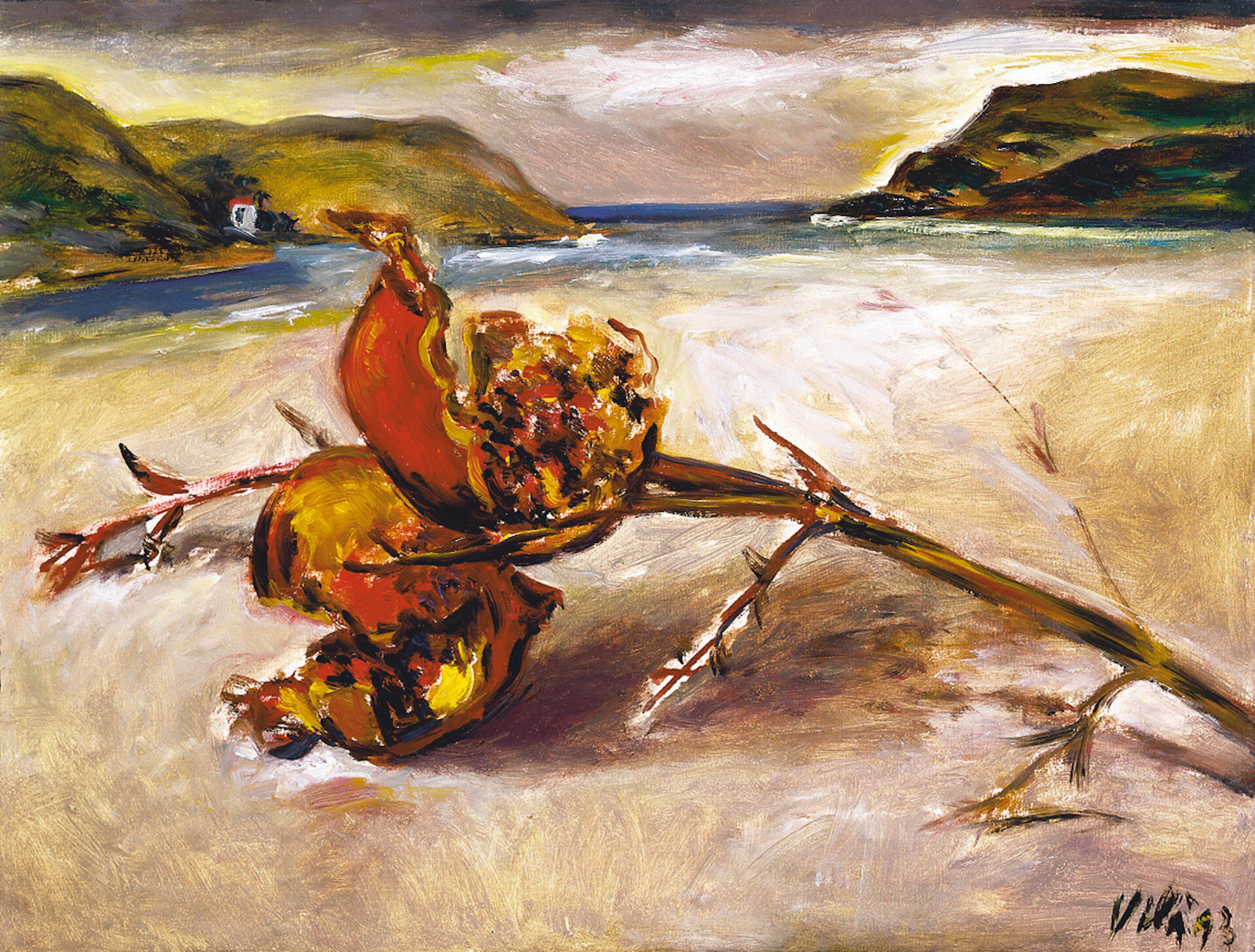
Francesc Fontbona
Miquel Vilà has consolidated his presence on the contemporary Catalan painting scene. The nearly one thousand five hundred paintings included in the present catalogue of his work objectively attest to Vilà’s considerable weight. But one thousand, five hundred, though it is a lot, is just a number and art cannot be evaluated quantitatively, though a significant number of pieces always serves to emphasize, if nothing more, the magnitude of an artist dedication and the density of a professional career.
Everyone is conditioned by the times, but the painter Miquel Vilà belongs to a generation particularly marked by its time period, a complex and uncertain one which -let’s not forget- has not yet been brought to the sort of close that would allow it to be viewed as something complete.
Vilà is one of the painters appearing on the Catalan art scene from the very beginning -even slightly earlier- of the decade of the 60s, precisely shortly after several Catalan artists of the previous generation had achieved resounding and, until then, unprecedented international success, that of the painters forming the group “Dau al Set”, who had ended up embracing Informalism. Therefore, when Miquel Vilà and his colleagues, at the time very young began painting, many people considered that nothing could be done in art -and even worse- with the dogmatism prevailing at the time, that nothing should be done- other than Informalism, a movement which continued to produce international recognition for Catalan art while the young newcomers tried almost heroically to do different things.
Informalism at the time was the unexpected trump card of new art in this country, and in addition, for us it had undeniably positive political connotations that made it specially valuable. Indeed, it was like a sort of strictly pictorial yet nearly explicit manifesto against the Franco regime that had been monopolizing and oppressing the country for some twenty years. It mattered little that the very same non-conformist art was used repeatedly by the dictatorship to wash his image internationally by officially supplying this type of works to international art biennials, and that the artists creating it were not very diligent in disassociating themselves from the operation. Despite all this, Informalism had become a dogma of progress, and it is well known that dogmas are indisputable and only admit assent.
But the fact is that Miquel Vilà and some of his young colleagues ignored the dogma and dared to seek their own, different solutions when they embarked on their personal creative careers. Nor did they ever consider ending up within any of the traditional pictorial trends, absolutely valid in their own right and in many cases still quite alive but that, from what they were concerned, had already expressed everything they could express. So they move on, into another direction. That was indeed a problematic decision, as beyond Informalism it seemed there was no possible “salvation”. Furthermore, the maîtres-à-penser (I’ve always asked myself why people with a functional brain would ever need anyone to tell them what to think) were prophets of a religion that, like every religion, did not admit heterodoxies. And on the political front, it was also endorsed, because it was perceived as the ultimate line of the international avant-garde at the time.
That daring move towards real heterodoxy was something Miquel Vilà paid for, and continues to pay for, even forty years later since, in not aligning himself with the prevailing forces at the time, he came to occupy the uncomfortable position of “independent”. And independent he continues to be, many years later, for having dared not to place his bets on the winning horse at the right time.
But the fact is that, while in this country there seemed to be no real salvation beyond Informalism, in Europe and the rest of the Western World, there was much more variety of artistic possibilities, even from positions at the extreme avant-garde. Here, there was an intense dispute between the advocates of figurative and abstract art, in which everyone acted in an extreme fashion: the artists coming from the consolidated pre-war tendencies were for the most part irritated by the young advocates of “abstraction”. However, the painters who represented the latter, instead of at least defending the validity of any avant-garde creation, only emphasized the non-figurative aspect, as if this factor was essential for and exclusive of artistic renewal; and many of them seem to ignore or underestimate, for example, the fact that perhaps the strongest of any new painters arriving to the international scene, Francis Bacon, was precisely a figurative artist who used conventional pigments to express himself in his creations.
When the mainstream demanded one thing, Miquel Vilà and a handful of other artists in his milieu had no problem doing other things. And it must be said that it was truly difficult to dissent in those times, in any case, a price had to be paid for doing so. It is always safer to travel in the company of those who have a papal bull than to travel alone or with others who are as disparate as yourself.
From a very early stage, Miquel Vilà was assured that he wanted to take up painting. And painting is practiced with pigments that were invented many centuries ago and have the advantage that they respond materially much better than other, rather poor substitutes that condemn the paintings made with them to visit the restores workshop after a few years to arrest their inexorable deterioration. Vilà knew from start that, in order to narrate things in color on a flat movable surface, such as oil on canvas -or on panel or cardboard- provided unsurpassed performance. Therefore, as he didn’t need to re-invent the wheel, he was able to dedicate his genius to creative matters.
Another thing that Miquel Vilà was assured from scratch was that, since Maurice Denis time, the subject of the painting had been relegated to the background in order to grant the leading role to the painting itself, to its pure and simple plastic values, he did not want to relinquish the evocative and therefore expressive effects that objects, places, and specific situations have as nuclear elements in the poetry of a piece of art.
Miquel Vilà studied at the Conservatori de les Arts del Llibre (Conservatory of the Arts of the Book) and at the Escola Superior de Belles Arts (Fine Arts School), both in Barcelona, and began his artistic career with several paintings created between 1959 and 1961. None of these earliest works were commonplace, nor did they participate in any of the established languages of the acclaimed avant-gardes.
Soon though, he moved from painting to concentrate on printmaking. Engraving is an intrinsic part of Miquel Vilà’s artist creation -he has always worked with it and on his early period, until 1968, it was nearly his only activity. Vilà defined his mature pictorial style around 1974. Before, he was searching, following a path not far from the one he would eventually took, yet more receptive to far-off Surrealist influences and nearby pop art stimuli. From the start, Rafael Santos Torroella, an art critic and great intellectual, yet whose carisma as an arbiter of criticism was not recognized -probably due to certain contemporazing postures he held in the political field- backed Miquel Vilà and his colleagues -students of Santos in Fine Arts- who were neither happy with becoming the epigones of Informalism once it had become the official line. The fact that Vilà exhibited at new independent galleries, away from any established movements, such as Ianua and particularly Sala Adrià in Barcelona, is also a significant factor that helps to define the profile of the emerging artist.
Some sentences by Santos appearing at newspaper “El Noticiero Universal” in October 1971, describe the essence of Miquel Vilà’s artwork at the time: “It is a Surrealism that should be quantified as magical, filled with more or less geometrazing and esoteric signs, and always imbued with a grave and melancholic atmosphere suggestive of of oneiric realms, possibly with disturbing childhood nostalgias”. If we remove the references to Surrealism, this portrait of Miquel Vilà’s artwork can be applied to all of his subsequent mature works.
From 1974, Vilà’s painting became increasingly purified, focusing on the essential, which does not at all mean that it became schematic or simplified. There was an evident will to eliminate elements that perhaps were more exterior than intimate, owing more to trends than to “inspirations”. And for a painter who does not want to dispense with these evocative effects of objects and places which I mentioned above, what this purification does is making precisely these “figurative” elements emerge unconsciously, elements which he is never tempted to describe in a naturalist manner, rather translating their forms always to produce a sort of archaic air.
Miquel Vilà belongs to a rare category within Contemporary Art, an unlabeled category which hinders the taxonomy that seems facilitate the job of an art analyst while, at the same time, places its members -as diverse in time and style as Regoyos, Pidelaserra, Feliu Elias, Ottone Rossi or De Pisis- in an unstable, creaking classification, never acclaimed by the administrators of plastic orthodoxy. They could be called the “unsettling authentic painters”, and this category would include those painters who, acting from the most profound depths of creative sincerity, refused, since the end of the 19th Century and throughout the 20th Century, to join consolidated movements or incorporate mechanisms of refinement that could erode the strong, unusual and primal expressiveness of their works.
The anti-naturalist and yet figurative Vilà’s art style has another surprising characteristic: the light. It is very obvious that the painter does not pretend to trap the viewer with illusionism but, at the same time, he refuses to relinquish the above stated well-recognizable references, which he bathes in a special light obtained through techniques that other painters reserve for results at the service of superficial fidelities but that, in his case, serve a symbolic or expressionist attempt rather than an a one into Realism.
Thanks to this light, Vilà make us to believe that many of these industrious and even dismal places filling his canvases are painted at dawn, when in fact, they are products created in the mind, in the solitude of the studio, who knows whether as a result of that disturbing childhood nostalgia that Santos Torroella detected so early in his work, that only use “realist” resources to play with the viewer in a game that the latter can only intuit.
It is in this game that Miquel Vilà’s art resides: Trying to explain it, if this was possible -I have stated before that painters are better explained through the brush and not the word-, would be a betrayal to him. It would be like disemboweling his art, an act not only unnecessary but one of poor taste.
The important thing is that his work will remain, a silent witness of a time that was richer than school books say. And perhaps, volumes such as this one will help to rewrite the art history of the 20th Century such that it is more in keeping with reality, which is what all serious history should aim at.
Francesc Fontbona
Miquel Vilà has consolidated his presence on the contemporary Catalan painting scene. The nearly one thousand five hundred paintings included in the present catalogue of his work objectively attest to Vilà’s considerable weight. But one thousand, five hundred, though it is a lot, is just a number and art cannot be evaluated quantitatively, though a significant number of pieces always serves to emphasize, if nothing more, the magnitude of an artist dedication and the density of a professional career.
Everyone is conditioned by the times, but the painter Miquel Vilà belongs to a generation particularly marked by its time period, a complex and uncertain one which -let’s not forget- has not yet been brought to the sort of close that would allow it to be viewed as something complete.
Vilà is one of the painters appearing on the Catalan art scene from the very beginning -even slightly earlier- of the decade of the 60s, precisely shortly after several Catalan artists of the previous generation had achieved resounding and, until then, unprecedented international success, that of the painters forming the group “Dau al Set”, who had ended up embracing Informalism. Therefore, when Miquel Vilà and his colleagues, at the time very young began painting, many people considered that nothing could be done in art -and even worse- with the dogmatism prevailing at the time, that nothing should be done- other than Informalism, a movement which continued to produce international recognition for Catalan art while the young newcomers tried almost heroically to do different things.
Informalism at the time was the unexpected trump card of new art in this country, and in addition, for us it had undeniably positive political connotations that made it specially valuable. Indeed, it was like a sort of strictly pictorial yet nearly explicit manifesto against the Franco regime that had been monopolizing and oppressing the country for some twenty years. It mattered little that the very same non-conformist art was used repeatedly by the dictatorship to wash his image internationally by officially supplying this type of works to international art biennials, and that the artists creating it were not very diligent in disassociating themselves from the operation. Despite all this, Informalism had become a dogma of progress, and it is well known that dogmas are indisputable and only admit assent.
But the fact is that Miquel Vilà and some of his young colleagues ignored the dogma and dared to seek their own, different solutions when they embarked on their personal creative careers. Nor did they ever consider ending up within any of the traditional pictorial trends, absolutely valid in their own right and in many cases still quite alive but that, from what they were concerned, had already expressed everything they could express. So they move on, into another direction. That was indeed a problematic decision, as beyond Informalism it seemed there was no possible “salvation”. Furthermore, the maîtres-à-penser (I’ve always asked myself why people with a functional brain would ever need anyone to tell them what to think) were prophets of a religion that, like every religion, did not admit heterodoxies. And on the political front, it was also endorsed, because it was perceived as the ultimate line of the international avant-garde at the time.
That daring move towards real heterodoxy was something Miquel Vilà paid for, and continues to pay for, even forty years later since, in not aligning himself with the prevailing forces at the time, he came to occupy the uncomfortable position of “independent”. And independent he continues to be, many years later, for having dared not to place his bets on the winning horse at the right time.
But the fact is that, while in this country there seemed to be no real salvation beyond Informalism, in Europe and the rest of the Western World, there was much more variety of artistic possibilities, even from positions at the extreme avant-garde. Here, there was an intense dispute between the advocates of figurative and abstract art, in which everyone acted in an extreme fashion: the artists coming from the consolidated pre-war tendencies were for the most part irritated by the young advocates of “abstraction”. However, the painters who represented the latter, instead of at least defending the validity of any avant-garde creation, only emphasized the non-figurative aspect, as if this factor was essential for and exclusive of artistic renewal; and many of them seem to ignore or underestimate, for example, the fact that perhaps the strongest of any new painters arriving to the international scene, Francis Bacon, was precisely a figurative artist who used conventional pigments to express himself in his creations.
When the mainstream demanded one thing, Miquel Vilà and a handful of other artists in his milieu had no problem doing other things. And it must be said that it was truly difficult to dissent in those times, in any case, a price had to be paid for doing so. It is always safer to travel in the company of those who have a papal bull than to travel alone or with others who are as disparate as yourself.
From a very early stage, Miquel Vilà was assured that he wanted to take up painting. And painting is practiced with pigments that were invented many centuries ago and have the advantage that they respond materially much better than other, rather poor substitutes that condemn the paintings made with them to visit the restores workshop after a few years to arrest their inexorable deterioration. Vilà knew from start that, in order to narrate things in color on a flat movable surface, such as oil on canvas -or on panel or cardboard- provided unsurpassed performance. Therefore, as he didn’t need to re-invent the wheel, he was able to dedicate his genius to creative matters.
Another thing that Miquel Vilà was assured from scratch was that, since Maurice Denis time, the subject of the painting had been relegated to the background in order to grant the leading role to the painting itself, to its pure and simple plastic values, he did not want to relinquish the evocative and therefore expressive effects that objects, places, and specific situations have as nuclear elements in the poetry of a piece of art.
Miquel Vilà studied at the Conservatori de les Arts del Llibre (Conservatory of the Arts of the Book) and at the Escola Superior de Belles Arts (Fine Arts School), both in Barcelona, and began his artistic career with several paintings created between 1959 and 1961. None of these earliest works were commonplace, nor did they participate in any of the established languages of the acclaimed avant-gardes.
Soon though, he moved from painting to concentrate on printmaking. Engraving is an intrinsic part of Miquel Vilà’s artist creation -he has always worked with it and on his early period, until 1968, it was nearly his only activity. Vilà defined his mature pictorial style around 1974. Before, he was searching, following a path not far from the one he would eventually took, yet more receptive to far-off Surrealist influences and nearby pop art stimuli. From the start, Rafael Santos Torroella, an art critic and great intellectual, yet whose carisma as an arbiter of criticism was not recognized -probably due to certain contemporazing postures he held in the political field- backed Miquel Vilà and his colleagues -students of Santos in Fine Arts- who were neither happy with becoming the epigones of Informalism once it had become the official line. The fact that Vilà exhibited at new independent galleries, away from any established movements, such as Ianua and particularly Sala Adrià in Barcelona, is also a significant factor that helps to define the profile of the emerging artist.
Some sentences by Santos appearing at newspaper “El Noticiero Universal” in October 1971, describe the essence of Miquel Vilà’s artwork at the time: “It is a Surrealism that should be quantified as magical, filled with more or less geometrazing and esoteric signs, and always imbued with a grave and melancholic atmosphere suggestive of of oneiric realms, possibly with disturbing childhood nostalgias”. If we remove the references to Surrealism, this portrait of Miquel Vilà’s artwork can be applied to all of his subsequent mature works.
From 1974, Vilà’s painting became increasingly purified, focusing on the essential, which does not at all mean that it became schematic or simplified. There was an evident will to eliminate elements that perhaps were more exterior than intimate, owing more to trends than to “inspirations”. And for a painter who does not want to dispense with these evocative effects of objects and places which I mentioned above, what this purification does is making precisely these “figurative” elements emerge unconsciously, elements which he is never tempted to describe in a naturalist manner, rather translating their forms always to produce a sort of archaic air.
Miquel Vilà belongs to a rare category within Contemporary Art, an unlabeled category which hinders the taxonomy that seems facilitate the job of an art analyst while, at the same time, places its members -as diverse in time and style as Regoyos, Pidelaserra, Feliu Elias, Ottone Rossi or De Pisis- in an unstable, creaking classification, never acclaimed by the administrators of plastic orthodoxy. They could be called the “unsettling authentic painters”, and this category would include those painters who, acting from the most profound depths of creative sincerity, refused, since the end of the 19th Century and throughout the 20th Century, to join consolidated movements or incorporate mechanisms of refinement that could erode the strong, unusual and primal expressiveness of their works.
The anti-naturalist and yet figurative Vilà’s art style has another surprising characteristic: the light. It is very obvious that the painter does not pretend to trap the viewer with illusionism but, at the same time, he refuses to relinquish the above stated well-recognizable references, which he bathes in a special light obtained through techniques that other painters reserve for results at the service of superficial fidelities but that, in his case, serve a symbolic or expressionist attempt rather than an a one into Realism.
Thanks to this light, Vilà make us to believe that many of these industrious and even dismal places filling his canvases are painted at dawn, when in fact, they are products created in the mind, in the solitude of the studio, who knows whether as a result of that disturbing childhood nostalgia that Santos Torroella detected so early in his work, that only use “realist” resources to play with the viewer in a game that the latter can only intuit.
It is in this game that Miquel Vilà’s art resides: Trying to explain it, if this was possible -I have stated before that painters are better explained through the brush and not the word-, would be a betrayal to him. It would be like disemboweling his art, an act not only unnecessary but one of poor taste.
The important thing is that his work will remain, a silent witness of a time that was richer than school books say. And perhaps, volumes such as this one will help to rewrite the art history of the 20th Century such that it is more in keeping with reality, which is what all serious history should aim at.
Francesc Fontbona
